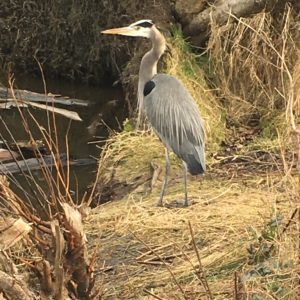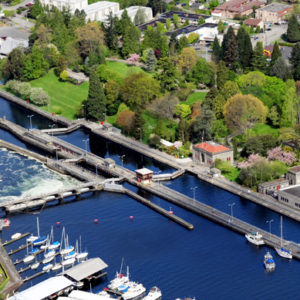Notes of an Urban Naturalist
 This Saturday (March 10) I will be one of a team of “urban naturalists” leading a Seattle Parks “Great Blue Heron Walk.” We meet at 10:00 at the the Environmental Learning Center at Discovery Park. From there we walk to the Heron rookery near the Ballard Locks.
This Saturday (March 10) I will be one of a team of “urban naturalists” leading a Seattle Parks “Great Blue Heron Walk.” We meet at 10:00 at the the Environmental Learning Center at Discovery Park. From there we walk to the Heron rookery near the Ballard Locks.
The GBH pictured right is one I spotted and photographed at Seattle’s Golden Gardens Parks, just north of us.
A decade ago there had been a rookery nearer to Discovery Park, in a ravine east of the park. The herons abandoned that site because of eagles. The eagles (along with gulls, crows and raccoons) go after the 3″ x 2″ light blue eggs of the herons. Typically there are two to six eggs in a nest.

Aerial view of Hiram M. Chittenden Locks (Photo Courtesy of Civil Air Patrol)
After the herons were chased out of that site, they moved to one nearer the Ballard Locks (right). One of the things that made that site advantageous was the presence of an osprey, a type of hawk that nests near lakes and waterways and feeds on fish. The osprey are not on good terms with the eagles. So the osprey provided protection for the herons and made that new rookery site more attractive.
Until . . .
Two years ago when someone sent their drone up to check out the osprey nest located just to the west of the Burlington Northern Railway Trestle. The osprey apparently didn’t care for the nosey and noisy drone and took off, leaving the heron rookery again exposed to the eagles. Drones are an issue in the park. People aren’t supposed to fly them there, but they do with adverse consequences for birds. Raptors (hawks, owls, eagles) have been known to take down drones.
Out in the Puget Sound hovering “whale boats” are a problem for Orca whales. On land, drones are posing a similar, though less noticed, threat to wildlife.
There are probably thirty heron nests in the rookery to the south and west of the Ballard Locks. Most are located high up in the surrounding alder trees.
Here’s a fun fact on how the herons make their nests. The male heron gathers sticks. The female heron then selects among the sticks, organizes and arranges them into the platform nest. That division of labor sounds familiar!
We often see herons flying across the waterway opposite our condominium. They like to hunt near Golden Gardens Park as well as along the North Beach area of Discovery Park. Golden Gardens offers several habitats to the hunting heron — ponds, marshes and tide pools. When hunting, herons stand stock still, until their prey is exposed. Then their coiled S-shaped neck makes a lighting quick movement. Prey is either grabbed in the pinchers of their beak, or stabbed by the beak in the case of a larger fish or rodent.
Another not-so-fun fact. If threatened by humans herons will strike with their beak. They go for the eyes. In some instances a heron beak strike has been so powerful that it has reached the brain and proven fatal. So don’t mess with herons. Don’t let the kids try to catch one to take it home for a pet.
And you were probably wondering about heron mating behavior? You know those long bills? They clack them with their mate. Doesn’t sound that exciting, but I guess it works. It also makes the rookery a kind of noisy place when mating is really in full swing.
Another of my upcoming programs is “Writing in the Wild,” on Saturday, April 28. We will set up camp for 3 hours in the woods of the park where the bird activity should be abundant come spring. I will give some “writing prompts” and we will let the creativity flow.
If you’re interested in either “Writing in the Wild” or this Saturday’s “Great Blue Heron Walk,” go to the Discovery Park website to register and get more information.
![Anthony B. Robinson [logo]](https://www.anthonybrobinson.com/wp-content/themes/anthonybrobinson/images/logo.png)
![Anthony B. Robinson [logo]](https://www.anthonybrobinson.com/wp-content/themes/anthonybrobinson/images/logo-print.png)